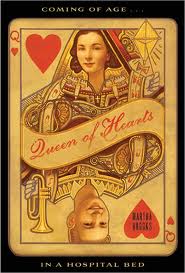Queen of Hearts by Martha Brooks
Reviewed by Keri

Ratings Explanation
Language: Several swear words and uses of Deity’s name
Violence: This takes place during World War II. Mention of friends and family members being killed in the war.
Sexual Content: Marie-Claire recalls being assaulted by a boy when she was younger. His idea of kissing included putting his hands up her skirt.
Marie-Claire and other patients find romance in the sanitorium.
Adult Themes: Many friends, neighbors and family die from tuberculosis. Infected family members are separated from one another to be hospitalized and confined in the sanitarium. Fear causes others to shun victims of the disease. Marie-Claire loses an uncle and a brother to tuberculosis. The family’s relationship is strained during the loss of one child and uncle and the long recovery period of the other two children. Marie-Claire’s discouragement leads her to question the existence of God and turn against religion.
Synopsis
Marie-Claire’s uncle comes to stay at her family’s home after being gone for several months living the life of a hobo. He is somewhat sickly with a constant cough, but Marie-Claire’s mother is determined to get him back on his feet. The uncle’s condition continues to worsen. A doctor is finally called and the uncle is diagnosed with tuberculosis. He is confined to the local sanitarium for treatment but ends up dying from the disease. Marie-Claire is heartbroken. The war also brings hardships to the community. The able bodied men are called to fight in the war leaving many of the elderly, young and women to take care of things in their absence. Marie-Clare too must help out more on the farm along with keeping up with her studies. When her brother, Luc, becomes sick, she takes over his chores too. In her weakened state, Marie-Claire becomes sick and so does her younger sister. After weeks of trying to carry on, her parents finally take the children to the doctor. The three of them are diagnosed with tuberculosis as well. Heartbroken, their parents take them to the sanitarium. The three of them are separated and moved in with others of their same sex and age. Marie-Claire worries most about her brother who has always been sickly. She begs to see him but is so sick herself that she is not allowed. Anger fills her heart. Even her kind roommate cannot seem to bring her around. Each day her anger deepens and her sickness worsens. She has no family, no privacy and no energy. When she hears that her brother is worse, she attempts to walk down the hall to see him but collapses. The doctor, seeing her determination, finally allows someone to wheel her to his room. Her parents are there along with a minister. She knows this will be the last time she will see her brother alive. After a few weeks, her kind room-mate Signy finally breaks through Marie-Claire’s angry barrier. They start to talk to one another and enjoy radio shows together. Signy has had the disease for years. Her parents are wealthy but rarely come to visit, yet her cheerful attitude and desire to get better warms Marie-Claire’s heart. With Signy’s help Marie-Claire slowly starts to recover. She finally gets to a point where the doctors release her to the cottages where she can regain more or her strength and work on being released. Upon learning this, Signy’s condition worsens. Marie-Clair is torn. She loves Signy and appreciates all that she has done for her, but a new world awaits her, far from sickness and filled with new friends and a new love. Marie-Claire must decide what matters most.
I really enjoyed this coming of age story. It is a part of history that we don’t hear much about. We are so fortunate to live in a world today with medical technology and advancements that prevent and cure so many of the horrible diseases of the past. I liked having the story told through Marie-Claire’s perspective. These were hard times and she felt every hardship. She wasn’t perfect. The battle for hope was real and a true struggle. After going through all that she did, Marie-Claire was given a greater challenge and that was to look outside of herself and help others through the same ordeal.









